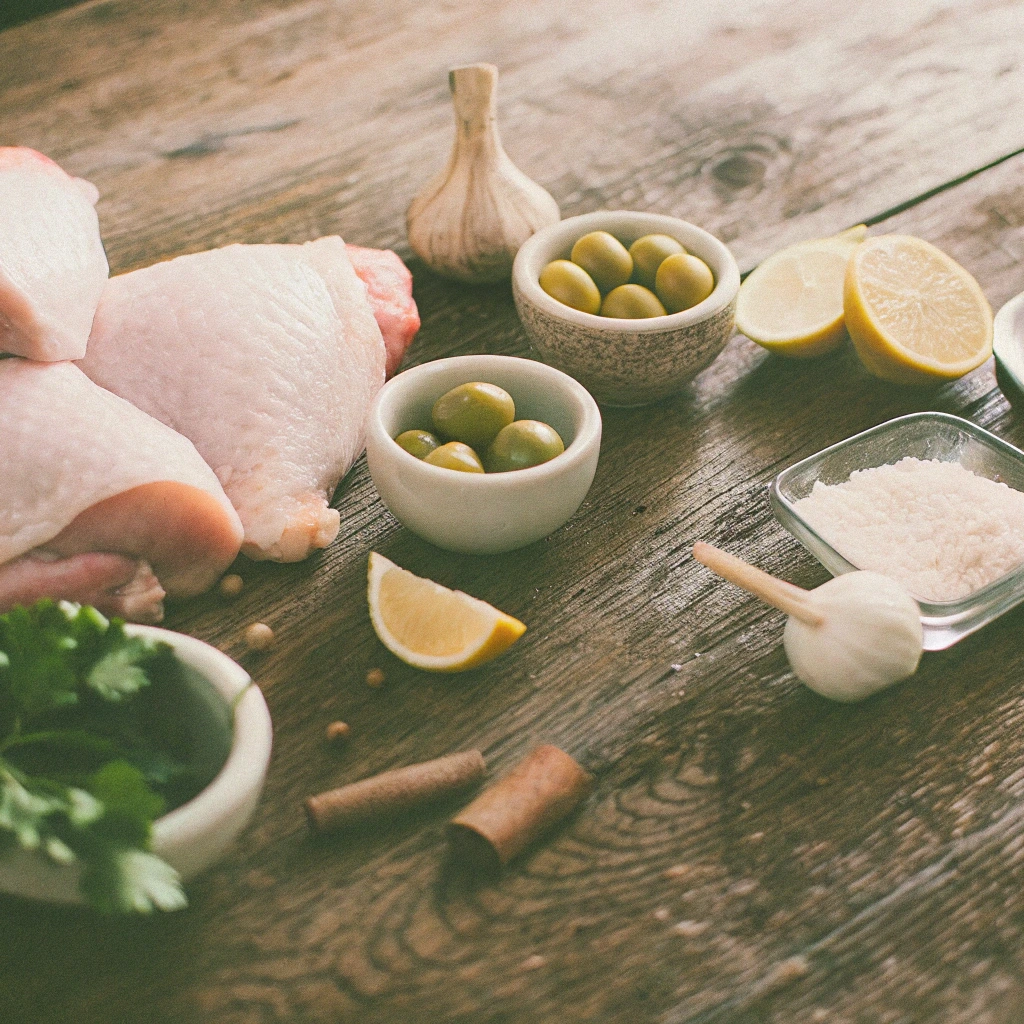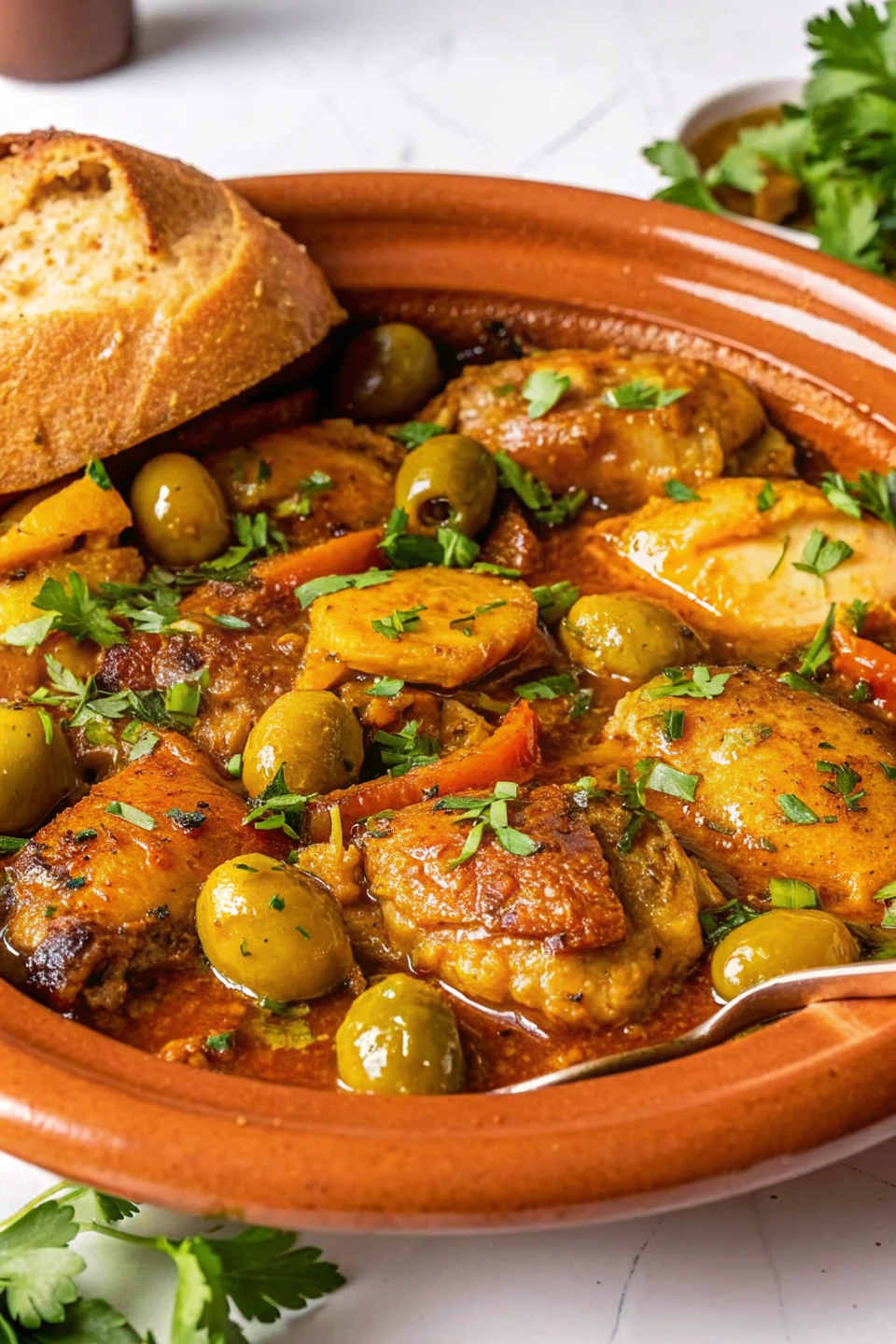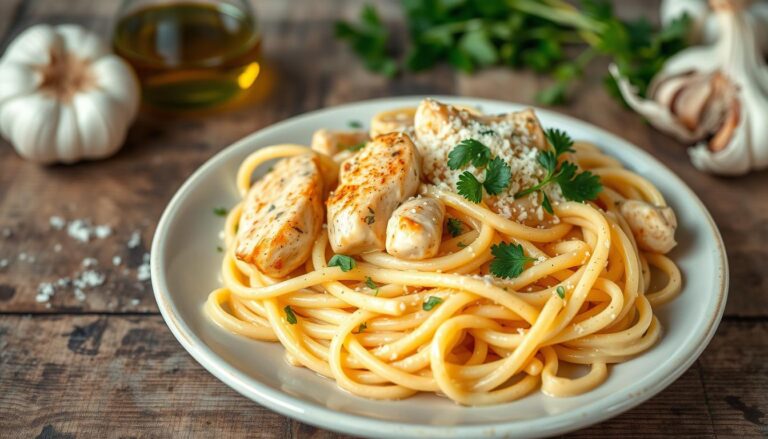Table of Contents
My Love Affair with Moroccan Chicken Tagine
The first time I tasted Moroccan chicken tagine, I was sitting in a tiny restaurant in Marrakech, watching steam curl from under a conical clay lid that was ceremoniously lifted at our table. The aroma alone told a story of distant spice markets and ancient cooking traditions. That moment changed my culinary perspective forever.
Today, I’m thrilled to share my version of Moroccan chicken tagine with you—a recipe I’ve perfected over years of testing and tweaking. Don’t worry if you don’t own an authentic tagine pot! This recipe works beautifully in a Dutch oven or heavy-bottomed pot, bringing Morocco’s soul-warming flavors right to your American kitchen.
What makes Moroccan chicken tagine so special isn’t just its complex flavors, but how those flavors transform everyday chicken into something truly extraordinary. The slow-cooking process allows the meat to become incredibly tender while absorbing the aromatic spices and sweet-savory contrasts that define Moroccan cuisine.
Let’s embark on this culinary journey together, shall we?
What Is a Moroccan Chicken Tagine?
A tagine (also spelled tajine) refers to both the North African conical-shaped cooking vessel and the savory stew prepared in it. This cooking method dates back centuries, originally using hot coals placed beneath and on top of the clay pot to create a self-basting, slow-cooking environment.
Moroccan chicken tagine combines tender chicken pieces with a brilliant medley of spices—typically cinnamon, cumin, coriander, and turmeric—along with preserved lemons, olives, and sometimes dried fruits. The magic happens when these ingredients slowly meld together, creating a dish that’s simultaneously comforting and exotic.
The distinctive dome-shaped lid of a traditional tagine pot serves an important purpose: it traps steam and returns condensation to the bottom, keeping the ingredients moist during long, slow cooking. But don’t worry—I’ll show you how to achieve these same wonderful results with cookware you likely already have.
Essential Ingredients for Authentic Moroccan Chicken Tagine

The Backbone: Chicken and Aromatics
- Chicken pieces – I prefer bone-in, skin-on chicken thighs for their flavor and juiciness, but a mix of thighs and drumsticks works beautifully too
- Onions – The foundation of any good tagine, providing sweetness as they slowly caramelize
- Garlic – Fresh is non-negotiable here; it creates a depth that powdered simply can’t match
- Fresh ginger – Adds a warm, slightly spicy brightness that balances the rich flavors
The Signature Spice Blend
- Ground cumin – Earthy and warm, quintessentially Moroccan
- Ground coriander – Citrusy and slightly sweet
- Ground cinnamon – Adds a subtle sweetness that complements the savory elements
- Turmeric – Provides gorgeous golden color and earthy flavor
- Paprika – I use sweet paprika for its color and mild pepper flavor
- Saffron threads (optional) – Expensive but authentic, adding a distinctive flavor and golden hue
The Special Additions
- Preserved lemons – These bring an intense, complex lemon flavor without acidity; they’re worth seeking out
- Green olives – Preferably Moroccan varieties like Picholine, but any good-quality green olives will work
- Dried fruits – Traditionally apricots or prunes, adding a sweet contrast
- Fresh herbs – Cilantro and parsley bring brightness and color to finish the dish
Don’t panic if you can’t find preserved lemons—I’ll share my quick substitute below, though I highly recommend trying the real thing if you can find them (or make your own!).
How to Make Moroccan Chicken Tagine: Step-by-Step Instructions
Preparing Your Ingredients
Before we start cooking, let’s get everything prepped and ready:
Prepare the chicken: Pat 2.5-3 pounds of chicken pieces dry with paper towels and season generously with salt and pepper on all sides.
Chop the aromatics: Finely dice 2 large onions, mince 4 garlic cloves, and grate or mince a 1-inch piece of fresh ginger.
Mix the spices: In a small bowl, combine 2 teaspoons ground cumin, 1.5 teaspoons ground coriander, 1 teaspoon ground cinnamon, 1 teaspoon turmeric, 1 teaspoon paprika, and a pinch of saffron threads (if using). Having this ready will make the cooking process smoother.
Prepare the add-ins: Rinse 1/2 cup green olives if they’re overly salty. Quarter 1-2 preserved lemons, removing the pulp and thinly slicing the rind. Roughly chop 1/2 cup dried apricots or prunes.
Cooking Your Moroccan Chicken Tagine
Now for the fun part—let’s get cooking!
Brown the chicken: Heat 2 tablespoons olive oil in your tagine, Dutch oven, or heavy-bottomed pot over medium-high heat. Working in batches to avoid crowding, brown the chicken pieces on all sides until they develop a beautiful golden crust, about 3-4 minutes per side. Transfer to a plate and set aside.
Create the flavor base: In the same pot, reduce heat to medium and add another tablespoon of oil if needed. Add the diced onions with a pinch of salt and sauté until they begin to soften, about 5 minutes. Add the garlic and ginger, cooking for another minute until fragrant.
Bloom the spices: Add your prepared spice mixture to the pot and stir constantly for about 30 seconds until aromatic. This crucial step wakes up the spices and releases their essential oils.
Build the sauce: Pour in 1.5 cups chicken broth and use a wooden spoon to scrape up any browned bits from the bottom of the pot—that’s flavor gold! Add 1 can (14.5 oz) diced tomatoes (if using), the preserved lemon rind, and dried fruits.
Return the chicken: Nestle the browned chicken pieces into the sauce, skin-side up. The liquid should come about halfway up the sides of the chicken, not covering it completely.
Slow cook to perfection: If using a traditional tagine, cover with the conical lid. For Dutch ovens or pots, cover tightly with a lid or foil. Reduce heat to low and simmer gently for 45-60 minutes, until the chicken is fall-off-the-bone tender.
Add the olives: About 15 minutes before the end of cooking, gently stir in the green olives.
Final touches: Once the chicken is tender, taste the sauce and adjust seasoning as needed. Scatter chopped fresh cilantro and parsley over the top just before serving.
Serving Suggestions
Traditional Moroccan tagine is typically served directly from the cooking vessel, placed in the center of the table for everyone to share. Serve your masterpiece with:
- Couscous – The classic accompaniment, perfect for soaking up the flavorful sauce
- Crusty bread – Try a rustic loaf or even warm pita bread
- Moroccan mint tea – The traditional beverage pairing that complements the meal perfectly
Tips for Making the Perfect Moroccan Chicken Tagine
Choosing the Right Cookware
While an authentic tagine pot adds wonderful flavor and presentation value, don’t let the lack of one stop you from making this dish! Here’s what works well:
- Traditional clay tagine: If using, remember to cure it before first use according to manufacturer’s instructions. Always heat it slowly to prevent cracking.
- Dutch oven: My go-to alternative—cast iron enameled Dutch ovens retain heat beautifully and create similar results.
- Slow cooker: For a hands-off approach, brown ingredients first then transfer to a slow cooker for 4-6 hours on low.
- Pressure cooker/Instant Pot: For quick results, use the sauté function to brown ingredients, then pressure cook for about 15 minutes.
Spice Wisdom for Authentic Flavor
- Toast whole spices: For even more flavor, start with whole cumin and coriander seeds, toast them in a dry pan until fragrant, then grind them fresh.
- Layer your spices: Add some at the beginning and reserve a small pinch to add in the final 10 minutes of cooking for brightness.
- Ras el hanout option: This Moroccan spice blend can replace the individual spices if you can find it. Use 2-3 teaspoons.
Make-Ahead and Storage Tips
Moroccan chicken tagine actually improves with time as flavors meld, making it perfect for:
- Next-day meals: Make it a day ahead and reheat gently for even better flavor.
- Freezing: Cool completely, then freeze in airtight containers for up to 3 months. Thaw overnight in the refrigerator.
- Refrigeration: Keeps well for 3-4 days in the refrigerator in a covered container.
Variations on Moroccan Chicken Tagine
Lemon and Olive Tagine
This classic variation emphasizes the bright, tangy flavors:
- Double the preserved lemon
- Increase olives to 1 cup
- Omit the dried fruits
- Add extra fresh lemon juice at the end
- Finish with more fresh herbs
Honey and Apricot Tagine
For those who enjoy sweeter tagine variations:
- Increase dried apricots to 1 cup
- Add 2 tablespoons honey
- Include 1/4 cup sliced almonds, lightly toasted
- Reduce olives or omit entirely
- Add 1/4 teaspoon ground ginger
Vegetable-Forward Tagine
Make it even heartier by adding vegetables:
- Add 1 diced sweet potato
- Include 1 sliced bell pepper
- Add 1 cup chickpeas (drained and rinsed)
- Throw in a handful of baby spinach in the last 5 minutes
- Consider adding diced zucchini in the last 15 minutes of cooking
Quick Weeknight Tagine
Need dinner on the table faster? Try this streamlined approach:
- Use boneless, skinless chicken thighs cut into 1-inch pieces
- Sauté everything in a wide skillet instead of a deep pot
- Cook uncovered for about 25 minutes, stirring occasionally
- Add a cornstarch slurry to thicken the sauce if desired
No Preserved Lemons? No Problem!
Preserved lemons add a distinctive flavor that’s hard to replicate, but if you can’t find them, here’s my quick substitute:
- Use the zest and juice of 1 fresh lemon
- Add 1/2 teaspoon of salt to the lemon zest and rub together with your fingers
- Add both to the tagine when you would add preserved lemons
It won’t be identical, but it’ll still be delicious while you source or make proper preserved lemons for next time!
Common Questions About Moroccan Chicken Tagine
Can I make Moroccan chicken tagine without a tagine pot?
Absolutely! While the traditional clay pot adds authenticity, a Dutch oven or heavy-bottomed pot with a tight-fitting lid works beautifully. The key is low, slow cooking with minimal evaporation.
What’s the best cut of chicken for tagine?
Bone-in, skin-on chicken thighs and drumsticks are ideal as they remain juicy and tender during long cooking. Breast meat tends to dry out, but if you prefer it, add it later in the cooking process.
Can I make Moroccan chicken tagine in advance?
Yes, and it actually gets better! Make it a day or two ahead, refrigerate, and gently reheat before serving. The flavors have more time to meld and develop.
What can I substitute for preserved lemons?
While nothing exactly matches their unique flavor, you can approximate it by using fresh lemon zest, a bit of juice, and extra salt. For a closer match, try salt-cured lemon peel made by mixing lemon zest with salt and letting it sit for an hour.
Is Moroccan chicken tagine spicy hot?
Traditional Moroccan chicken tagine is aromatic and flavorful but not spicy hot. If you enjoy heat, add harissa paste or cayenne pepper to taste.
Can I add vegetables to my tagine?
Definitely! Carrots, bell peppers, zucchini, and chickpeas are all wonderful additions. Add root vegetables early in the cooking process and more delicate vegetables in the last 15-20 minutes.
How do I know when my chicken tagine is done?
The chicken should be very tender—almost falling off the bone. When you insert a knife, the juices should run clear, and the meat should pull away from the bone easily.
Bringing Morocco to Your Table
There’s something magical about gathering around a steaming Moroccan chicken tagine with family and friends. The communal nature of the dish, served from the center of the table, invites conversation and connection—something we could all use more of these days.
I hope this recipe brings not just delicious flavors to your table, but also a sense of adventure and a moment to slow down and savor both the food and the company. Moroccan cooking reminds us that good things come to those who wait, as the slow simmer of this dish transforms humble ingredients into something truly extraordinary.
Have you tried making Moroccan chicken tagine before? I’d love to hear about your experience! Drop a comment below sharing your favorite tagine variations or any questions you might have. And if you make this recipe, please come back and let me know how it turned out—nothing makes me happier than knowing these recipes are being enjoyed in homes across the country.
Until next time, happy cooking!
Hungry for more? Check out our top rated recipes :







